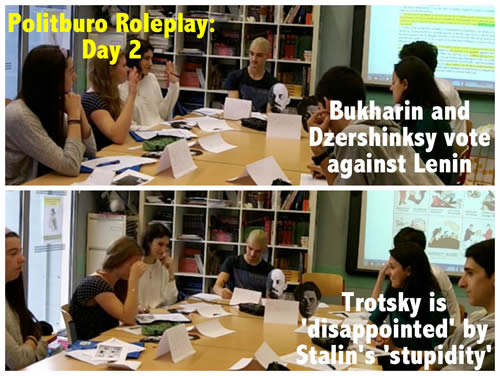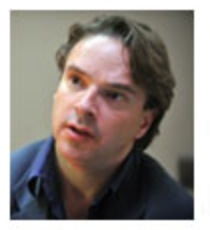Transform your history classroom
ActiveHistory provides educational, award-winning interactive simulations, decision-making games, self-marking quizzes, high-quality worksheets and detailed lesson plans for the school history classroom. All resources have been designed by full-time history teacher Russel Tarr.
An ActiveHistory subscription provides everything you need to construct and deliver a History course from start to finish for the entire 11-18 age range!
These consist not just of lesson plans, worksheets and teacher notes, but also multimedia lectures and interactive games and historical simulations ideal for remote learning and self-study.
World History teaching resources for the high school classroom: lesson plans, worksheets, quizzes and simulation games for KS3, IGCSE, IB and A-Level teachers.
 This unit is taught completely through roleplay! Each student takes on the role of a different Politburo member and researches 'their' perspective on the key issues facing the new Soviet state. The teacher takes the role of President Kalinin, acting as Chair. Each lesson then works through issues "as they arise" between 1918-24, with plentiful use made of primary sources and round-table discussions. As Lenin's decisions on each issue are outlined, students can then make notes not just on 'what happened' but on how controversial these decisions were and how far Lenin was abandoning his communist ideology in favour of pragmatism; they will also get a very thorough understanding of the different splits in the party which Stalin is later able to exploit to such devastating effect.
This unit is taught completely through roleplay! Each student takes on the role of a different Politburo member and researches 'their' perspective on the key issues facing the new Soviet state. The teacher takes the role of President Kalinin, acting as Chair. Each lesson then works through issues "as they arise" between 1918-24, with plentiful use made of primary sources and round-table discussions. As Lenin's decisions on each issue are outlined, students can then make notes not just on 'what happened' but on how controversial these decisions were and how far Lenin was abandoning his communist ideology in favour of pragmatism; they will also get a very thorough understanding of the different splits in the party which Stalin is later able to exploit to such devastating effect.
Google Hangout Video Conference: Professor Orlando Figes answers questions on Lenin's Russia
 Following his earlier talk with students on the subject of the 1917 October Revolution, Professor Orlando Figes of Birkbeck University answered questions from students at the International School of Toulouse on the topic of Lenin's rule of Russia 1918-1924.
Following his earlier talk with students on the subject of the 1917 October Revolution, Professor Orlando Figes of Birkbeck University answered questions from students at the International School of Toulouse on the topic of Lenin's rule of Russia 1918-1924.
Over the course of 45 minutes he answered a wide range of questions that the class had formulated in advance following an in-depth study of Russian history.
The video conference was broadcast live via Google Hangouts and was viewed by more than 30 schools around the world.
You can view the full video, with links to the questions asked, on this page.
Lenin and the USSR: An Interactive Decision-Making Adventure |
Take on the role of a Politburo heavyweight and see how successfully you help Lenin to rule the USSR between 1917-24. A great simulation for approaching what can be a very complicated topic! Best used EITHER at the end of the teaching phase (but before writing the essay) OR during the revision period, to help consolidate understanding and provide fresh evidence. |
1917: Introduction
Start the lesson by having this image of the 1917 Politburo on the screen. I also like to have "Back in the USSR" by the Beatles playing in the background as students walk in!
Students then use this framework to think through the main issues facing Russia directly after the Bolshevik takeover.
These sources on the 1917 Decrees and the 1918 Constitution are then used to examine and assess Lenin's reaction to these problems. The correct answers to the questions relating to the 1918 Constitution can be found here.
Homework
Students use this record sheet to conduct some research on their allocated Politburo character. The same sheet will form the basis of note-taking for the remainder of the unit.
1918: Constituent Assembly
Introducing the Poltiburo!
Each student introduces themselves to the rest of the group prior to the main roleplay session taking place.
The Problem of the Constituent Assembly
Why has the Constituent Assembly turned out to be such a disappointment to the Bolsheviks? How can we justify our decision to close it down?
As stimulus material for this discussion the class should also use this Bolshevik propaganda cartoon justifying the closure of the assembly, and this video clip.
Lenin's Decision
We now consider what Lenin has actually decided to do and use this to develop our record sheet with evidence of success and failure. This video clip can also be used for extra detail.
1918: Brest Litovsk
The Problem of World War One
The Politburo is briefed on the ongoing problem of the Great War and the different members of the Politburo offer suggested approaches.
Lenin's Decision
The decision of the Bolshevik leader and the immediate aftermath is considered. Students make notes of success and failure as appropriate. This video clip covers Lenin's belief that a world revolution would soon make the Treaty of Brest-Litovsk irrelevant.
1918: War Communism
The Economic Crisis
The Politburo is briefed on the ongoing problem of the Civil War and the members of the Politburo offer possible responses. As further stimulus, students should consider the message of 'Babluki and the Baba', a Bolshevik propaganda cartoon.
Lenin's Decision
The politburo looks at Lenin's solution of 'War Communism' and considers whether it should be regarded as a successful response to the crisis.
1918: Red Terror
Introductory Presentation: The Assassination Attempt on Lenin
As students enter the classroom, I provide a piece of rag for Lenin to hold to his neck. The presentation then outlines the assassination attempt and provides a backdrop to the Red Terror.
The Problem
Students use this framework to make notes from the PowerPoint, and to consider how we should respond to the negative propaganda being generated by the Red Terror.
The Response
A series of direct quotes from the Politburo members are read out to the group. Which are particularly effective at justifying the Red Terror ideologically and / or pragmatically? The following video clips provide useful extra material: [1], [2], [3]
1919: Civil War
The Problem
The Politburo considers the problems being created by the Civil War and uses a presentation of propaganda images to determine how successfully the Bolsheviks are winning the propaganda war.
The Response: Did the Bolsheviks win, or did the Whites lose, the Civil War?
A summary of the key factors for Bolshevik success in the Civil War. The Politburo needs to consider whether the Bolseviks deserve to regard this was as a 'success' in that they won it by their own efforts, or a failure in the sense that the Whites merely lost the war. They should then use the following video clips to develop their notes: [1] [2]
1921: Revolts
The Problem: Tambov Rebellion in the Countryside, Kronstadt Rebellion in the Cities
This presentation outlines the key problems faced by the government.
The Problem: The Demands of the Tambov Rebels and the Kronstadt Sailors
The Politburo reads through the demands of the rebels and decides how to respond.
The Response: NEP
Lenin's policy of NEP is examined and assessed. The following video clip provides more detail: [1] [2]
1922: National Minorities
Stalin and Friends
I have this image on the screen as the students enter the room. Its relevance will soon become clear!
The Problem: A difficulty in delivering on our promise of full independence to national minorities
The Politburo discusses the problem and votes on one of two possible courses of action.
The Response: Stalin is sent to Georgia, Lenin is moved to rebuke him
The Politburo is informed of Stalin's rather brutal handling of the Georgian issue, and of Lenin's response to this. What elements of this affair deserve to be regarded as successes, and which as failures?
This information sheet should be used to develop notes further, as should the following video clip.
1922-24: The Testament
The Problem: Divisions in the Party
The Politburo considers the dangerous divisions in the party and possible responses to it.
The Response: Party Factions and the Testament
We end by considering Lenin's decision to ban party factions and to refuse to name a clear successor. Is this the right policy?
Essay Planning and Preparation
Classroom Debate and Conclusions
In this activity students assess how far Lenin delivered on his stated promises of "Peace, Bread and Land" and "All Power to the Soviets" for the Russian people. Pairs of students are pitted against each other to debate particular themes, and the rest of the class provides judgements. This can then be converted into an essay using the guidance provided.
Lenin's Rule of Russia: Article by Russel Tarr in History Review Magazine
After the debate has taken place and the essays are thereby planned, students can be provided with this "model essay" by the author of this website to help them gather further ideas and evidence to include in their essays.
Online Video Resources from YouTube/Vimeo
Lenin's Russia [1] (20m)
Lenin's Russia [2] (50m)
Lenin's Russia [3] (20m)
Interactive Games
| 1. | Fling the Teacher Quiz - USSR under Lenin |
| 2. | KeyWord Challenge: Lenin's Russia [Interactive] If you are unfamiliar with the format of the game, click here for instructions. |
| 3. | "Who Am I?" Challenge: The Rule of Lenin Each team will be presented with a clue about a key historical figure. They get 50 points if they guess it correctly. If they wish to 'pass', they get further (easier) clues but the points available steadily decline. An incorrect guess at any point means they get zero points for that round. You can play as many rounds as you wish. It's a great way to revise! |
Revision materials to use towards the end of the course
The Historiography of Lenin's Russia
This helps students review and develop their judgements of Lenin's USSR from a fresh perspective rather than merely revisit their notes. A range of different interpretations are provided and students need to decide which they find the most convincing and why.
"Compare and contrast the roles of Lenin and Trotsky 1917-1924" / "To what extent did Lenin sacrifice principle to maintain his hold on power?"
This worksheet guides students back through the topic, reframing their thoughts and notes to prepare them for two other possible questions that could appear on the examination paper.
Alternative Approach - Lenin's Russia as a worksheet-based unit
(more detailed, but less interactive)
Interactive Simulations to use at appropriate points in the unit
| 1. | Decision-making Game
|
| 2. | Interactive Running Dictation Exercise
|

© 1998-2025 Russel Tarr, ActiveHistory.co.uk Limited (Reg. 6111680)
1 Torrin Drive, Shrewsbury, Shropshire, SY3 6AW, England
Privacy Policy | Contact







